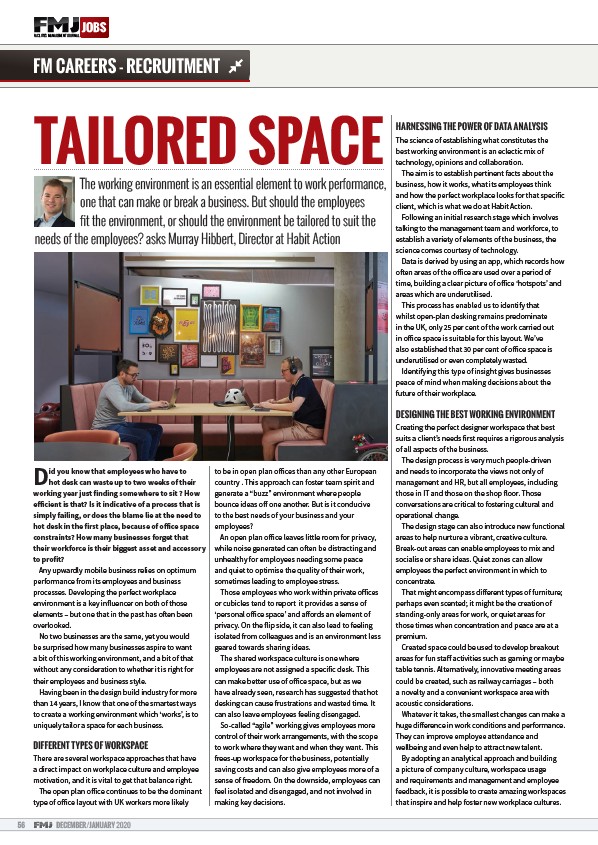
FACILITIES MANAGEMENT JOURNAL JOBS
FM CAREERS - RECRUITMENT
Did you know that employees who have to
hot desk can waste up to two weeks of their
working year just finding somewhere to sit ? How
e icient is that? Is it indicative of a process that is
simply failing, or does the blame lie at the need to
hot desk in the first place, because of o ice space
constraints? How many businesses forget that
their workforce is their biggest asset and accessory
to profit?
Any upwardly mobile business relies on optimum
performance from its employees and business
processes. Developing the perfect workplace
environment is a key influencer on both of those
elements – but one that in the past has o en been
overlooked.
No two businesses are the same, yet you would
be surprised how many businesses aspire to want
a bit of this working environment, and a bit of that
without any consideration to whether it is right for
their employees and business style.
Having been in the design build industry for more
than 14 years, I know that one of the smartest ways
to create a working environment which ‘works’, is to
uniquely tailor a space for each business.
DIFFERENT TYPES OF WORKSPACE
There are several workspace approaches that have
a direct impact on workplace culture and employee
motivation, and it is vital to get that balance right.
The open plan o ice continues to be the dominant
type of o ice layout with UK workers more likely
to be in open plan o ices than any other European
country . This approach can foster team spirit and
generate a “buzz” environment where people
bounce ideas o one another. But is it conducive
to the best needs of your business and your
employees?
An open plan o ice leaves little room for privacy,
while noise generated can o en be distracting and
unhealthy for employees needing some peace
and quiet to optimise the quality of their work,
sometimes leading to employee stress.
Those employees who work within private o ices
or cubicles tend to report it provides a sense of
‘personal o ice space’ and a ords an element of
privacy. On the flip side, it can also lead to feeling
isolated from colleagues and is an environment less
geared towards sharing ideas.
The shared workspace culture is one where
employees are not assigned a specific desk. This
can make better use of o ice space, but as we
have already seen, research has suggested that hot
desking can cause frustrations and wasted time. It
can also leave employees feeling disengaged.
So-called “agile” working gives employees more
control of their work arrangements, with the scope
to work where they want and when they want. This
frees-up workspace for the business, potentially
saving costs and can also give employees more of a
sense of freedom. On the downside, employees can
feel isolated and disengaged, and not involved in
making key decisions.
HARNESSING THE POWER OF DATA ANALYSIS
The science of establishing what constitutes the
best working environment is an eclectic mix of
technology, opinions and collaboration.
The aim is to establish pertinent facts about the
business, how it works, what its employees think
and how the perfect workplace looks for that specific
client, which is what we do at Habit Action.
Following an initial research stage which involves
talking to the management team and workforce, to
establish a variety of elements of the business, the
science comes courtesy of technology.
Data is derived by using an app, which records how
o en areas of the o ice are used over a period of
time, building a clear picture of o ice ‘hotspots’ and
areas which are underutilised.
This process has enabled us to identify that
whilst open-plan desking remains predominate
in the UK, only 25 per cent of the work carried out
in o ice space is suitable for this layout. We’ve
also established that 30 per cent of o ice space is
underutilised or even completely wasted.
Identifying this type of insight gives businesses
peace of mind when making decisions about the
future of their workplace.
DESIGNING THE BEST WORKING ENVIRONMENT
Creating the perfect designer workspace that best
suits a client’s needs first requires a rigorous analysis
of all aspects of the business.
The design process is very much people-driven
and needs to incorporate the views not only of
management and HR, but all employees, including
those in IT and those on the shop floor. Those
conversations are critical to fostering cultural and
operational change.
The design stage can also introduce new functional
areas to help nurture a vibrant, creative culture.
Break-out areas can enable employees to mix and
socialise or share ideas. Quiet zones can allow
employees the perfect environment in which to
concentrate.
That might encompass di erent types of furniture;
perhaps even scented; it might be the creation of
standing-only areas for work, or quiet areas for
those times when concentration and peace are at a
premium.
Created space could be used to develop breakout
areas for fun sta activities such as gaming or maybe
table tennis. Alternatively, innovative meeting areas
could be created, such as railway carriages – both
a novelty and a convenient workspace area with
acoustic considerations.
Whatever it takes, the smallest changes can make a
huge di erence in work conditions and performance.
They can improve employee attendance and
wellbeing and even help to attract new talent.
By adopting an analytical approach and building
a picture of company culture, workspace usage
and requirements and management and employee
feedback, it is possible to create amazing workspaces
that inspire and help foster new workplace cultures.
TAILORED SPACE
The working environment is an essential element to work performance,
one that can make or break a business. But should the employees
fi t the environment, or should the environment be tailored to suit the
needs of the employees? asks Murray Hibbert, Director at Habit Action
56 DECEMBER/JANUARY 2020